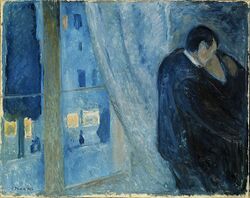Claude Monet

“At least people don't think your name is something to do with the change left over from buying contraceptives”
Claude Monet, pronounced in America as (Monet) (November 14, 1840 – May 25, 1926) was the most prolific painter in French history. It’s common knowledge that one Monet painting is worth two Van Gogh's, fifty Manet's, and half of a Picasso.
Monet like many other famous artists prefers to be referred to by only his last name, and was oft famously quoted reminding people- “Please, my father was Mr. Monet, and he was an unknown grocer. I’m the one and only Monet.”
Biography
Early Life
Related to the Monet-Baggs family of Normandy, Claude "Dirty" Monet was fond of bunnies, and his lunch money; deciding at age eight to escape to attend art school. His early childhood in Paris (his family moved to Le Havre around the time of his 5th birthday following a difference of opinion over the rent with their local landlord) left him with a lifelong love of rioting and beret-wearing that would influence his art during the early years of his career.
He first became known locally for his charcoal caricatures, which he would sell for ten to twenty francs. This set him apart from other artists, who would traditionally exchange their works for items such as pints of beer, food or in some cases small villages in Tuscany. Monet became the first artist to charge for his work, a methodology that would bear his name thereafter, the Monetary System.
As his fame and talent increased he sought out new techniques to keep his art "cutting edge" and "interesting". Instead of painting the exciting still life of bananas like his contemporaries Monet painted landscapes. Except he wasn’t very good at painting landscapes straight away. He invented blurriness or impressionism to cover for this lack of talent. Smearing paint across the canvas in rough strokes seemed infinitely easier than painstakingly painting every little part of the herbaceous plant.
Gay Paree
Monet spent his time in Paris the same way you spent your time in high school: copying off the works of others. Manet, Rodin, Sisley, and a bunch of other painters you couldn't pick out of a lineup all complained to the University: “Monet is stealing my scenery. I painted the river Seine, Monet painted it. I painted the Cathedral of Notre Dame, Monet painted it. It’s outrageous! Monet est un tricheur!”
In 1862 bearded Prostitute artist Édouard Manet accused Monet of "trying to steal my name, nes pa?" The scandal threatened to force Monet out of his beloved Art d'escole, with Manet stating that he would "show the young upstart how gay Gay Paree could be, non?" Monet paid the artist off, buying Manet his own brothel, and the two would go on to become the best of friends.
Perhaps the most famous location used for painting by Monet was his gardens at Giverny. Here he could mass produce a seemingly endless number of prints concerning water lilies, unicorns, and other icons of gay culture. One of his most famous paintings of this period "Rainbows et Mardi Gra" was recently purchase by the New York Diversity Group for in excess of $4 million.
The Tortured Artist
Monet created the stock character “The Tortured Artist”. Repeated suicide attempts by throwing himself in the Seine, making unreasonable demands concerning the preparation of grilled cheese sandwiches (one slice of cheese unmelted between two melted slices!), and smoking during intercourse led to the death of his first wife Camille.
Doctors claim Camille died of tuberculosis, but we know… it was from a broken heart; don’t we girls!
Monet became overtaken by his own emotions and inner personal conflicts. Frustrated he would often break the paintbrushes of students who couldn’t even manage to: “Paint a pipe that’s not even there!”
Monet felt that if you’re going to waste your time creating art you better have the persona to go with it. You’re a genius, you shouldn’t have to wash your own dishes. This attitude while admirable to most alpha males led to the creation of the “En plein air” movement in painting. Or in other words - “You're painting outside, and you're sleeping on the couch.”
Later Years
Without giving away too much, Monet died. But just before he died he did a lot of unsavory things. He had mistresses, he even had the widow of his benefactor raise his children. People say he was snarking this widow before his friend had even died.
One such incident was painted by rogue postimpressionist (and private eye) Edvard Munch. Munch would later testify about the evidence- “I didn’t have time to paint her face too, so I just made it look like Monet was really going for it.”
Death
Monet died of lung cancer at age 86. Which was a real bummer since he didn’t get any last words through all that unpleasant coughing, spitting, and choking. He had planned to upstage Van Gogh’s last words: “The sadness will last forever” with: “Please add at least 500% value to all of my works.”
Known works
Further Resources
| Featured version: 10 January 2012 | |
| This article has been featured on the main page. — You can vote for or nominate your favourite articles at Uncyclopedia:VFH. | |
{{DEFAULTSORT:Monet, Claude






